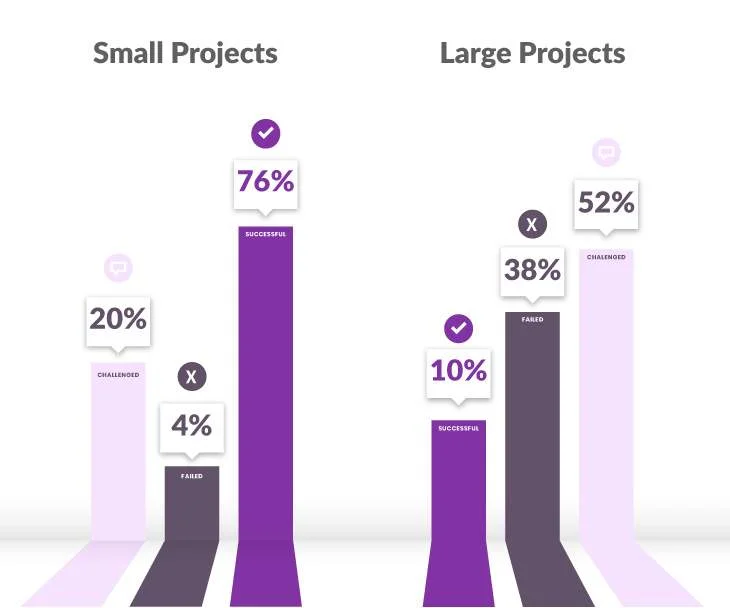IT companies that offer outsourced nearshore app development services must understand the clues to truly attending clients, determining responsible estimations, and backing clients by sharing responsibility when necessary. Other ways to measure the general perception of responsibility are the corporate culture and how similar it is to the client’s country. Colombia has been improving this perception during the last few years by showing clients in North America high commitment and a very similar corporate culture.
Software Development, and Nearshore App development Success in Bogota, Colombia vs the General Perception
Focusing on software development, the general perception is not encouraging, but it looks like there are still possibilities to improve. Agile methodologies have improved the success perception, though. Let’s have a look at the general perception first.

The above chart shows that only 23% of projects were developed in time and on budget. While 58% had failures in budget or time performance, 19% simply were not able to finish or to publish.
The perception of Bogotá city according to small and medium companies, in terms of its IT projects is generally successful and is described in the graphic below:

That is a satisfaction rate of 37%, above the general perception, but still with a need to improve, applying certain features that are involved in agile methodologies, but not always used.
How to Help Our Clients Feel Real Confidence in Nearshore App development
you might intertest eCommerce App Development
Let’s suppose you have a great team, try your best at planning and executing your project, but unfortunately, the project is not in time, and the client spent the planned budget. Usually, you have a difficult situation to handle your client and explaining why the project needs more time, and therefore more development hours that must be paid, creating a challenging-project. Satisfaction and confidence are being sacrificed.
If that is the situation, then your client is assuming the responsibility, because he/she spends more money, and waits longer than expected (risking the project accurate end). In such a case, it is appropriate to share responsibility, rather than just give explanations, and justifying the delay, giving all responsibility to the client.
For example, here at Foonkie Monkey, we created a shared responsibility policy where if tasks are not done in time according to the scope. All of our rates decrease by 50% until all required tasks are done.
The main goals of implementing this policy are:
- To incentivize all of our discovery team – IT consultants, architects, project managers – to have a better and more detailed planning process in order to be as accurate as possible
- To help our clients understand that their project is ours as well, that they are really supported by our team and that the client is not taken as a third party.
But How do You Deliver in Time as Scoped in Budget?
This is the $100 million question. Generally, since agile methodologies are being applied (in detail), small projects tend to have a better chance of success than large projects.

To develop a large project, a very detailed and iterative discovery stage must be implemented; the objective is to reduce the main issues related with the development which are:
- Uncertainty
- Vision
- Priorities
- Complexity of requirements
- Fluent and continue communication
One option that has been proven with great results is:
- During the discovery and planning stages we identify the main priorities and the minimum requirements to generate an MVP
- The MVP must have a 100% certainty in terms of a clear vision, and detailed requirements
- A fluent and continuous communication process is needed during the execution.
This way, the client feels a real agile product is being developed, and finds help to clear the vision and priorities of his project for the next stages. Finally, at the end of a planning process, it is a good idea to offer a preventive bag of extra hours in case there are more requirements that have been identified during the execution, this way the client has included these expenses into his initial budget.
In other words, the main purpose is to help your client develop the project by sharing the responsibility, that way all members of the team will do their best to accomplish each task. In the end, the success of any project is not measured in working hours but in accomplishing goals together instead.
